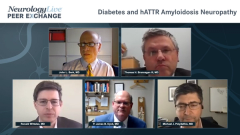
Disparities in Prevalence of hATTR Amyloidosis
A discussion on understanding the disparities of race and gender in hereditary ATTR amyloidosis.
Episodes in this series

John L. Berk, MD: I’d like to talk a little about whether there are gender or racial disparities in the prevalence of disease. Dr Brannagan, you live in a city New York of marked gender and racial hot issues at the moment. Is this a disease set that really resonates with that?
Thomas H. Brannagan III, MD: I think many of these issues with racial disparities in medicine in general have been discussed. There’s some thought about how this affects ATTR [amyloidosis]. Certainly the V122I mutation has been mentioned as a very common disorder in African American people. More men than women have ATTR. Separate from the differences in racial populations and differences in gender, there’s also an issue of economic disparity. The medications available for these disorders are exciting and effective, but also costly.
John L. Berk, MD: Thank you. Dr Witteles, about cardiomyopathy and gender disparities; can you contrast wild-type with hereditary amyloid cardiomyopathy?
Ronald Witteles, MD: I’d be happy to. To quickly add to the last topic, though, I’ll point to a very nice manuscript in 2018 by first author Kevin Alexander, MD, who is now at Stanford University Medical Center, that looked at racial disparities in diagnosis. It showed that the southern states, which have the highest percentage of Black population, have also the lowest percentage of amyloidosis diagnoses. The state that had by far the highest and the counties that had by far the highest were in Minnesota, Mower and Olmsted counties, right around Rochester.
P. James B. Dyck, MD: Yay us!
Ronald Witteles, MD: Yes, exactly. This is where people lived and not where they got the diagnosis made. It shows how important it is that the community look for the disease, particularly in populations where it’s known. It’s clearly not that there’s so much more of the disease around the Mayo Clinic, it’s that they live in an area that has an institution where it’s thought of all the time.
P. James B. Dyck, MD: Are you saying that everybody should move to Olmsted County, Minnesota, and get their health care at the Mayo Clinic?
Ronald Witteles, MD: Apparently only if they want to have amyloidosis is how I take it.
P. James B. Dyck, MD: It’s -10 degrees Fahrenheit outside right now for all of those of you who want to move here.
Ronald Witteles, MD: And it’s in the 60s out here in Palo Alto, California. Back to your question about the differences between men and women: there’s no question that there is a real male predominance certainly in the wild-type form of the disease. How much of that is due to diagnosis versus real difference is hard to say. However, I think it’s pretty clear there is a real difference with it being a lot more common in men. For the variant or hereditary forms, it does somewhat vary by mutation. For V122I, it’s closer to the wild-type side, where again it manifests itself much more in men than women, although women can absolutely have the disease, it’s just less common. As you get to some of the other mutations, that strong predominance of men sometimes goes away, and you’ll see much more equal phenotypes.
John L. Berk, MD: Thank you for watching this NeurologyLive® Peer Exchange. If you enjoyed the content, please subscribe to our e-newsletters to receive upcoming Peer Exchanges and other great content right in your inbox.
Transcript Edited for Clarity
Newsletter
Keep your finger on the pulse of neurology—subscribe to NeurologyLive for expert interviews, new data, and breakthrough treatment updates.































